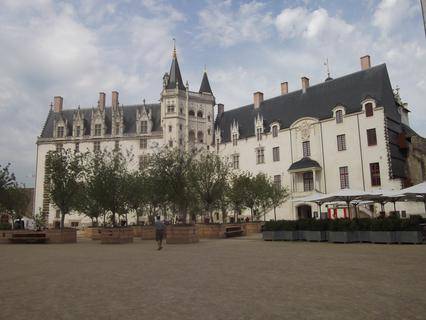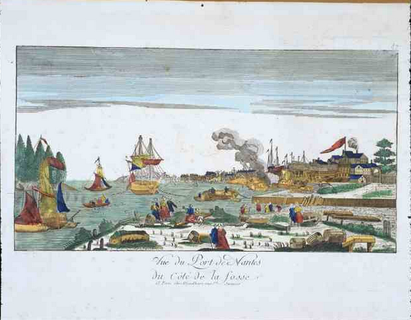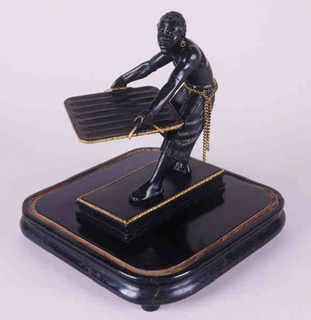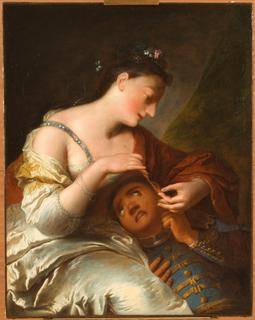Dark history in France
The Slavery trail in Nantes History Museum
a guest blog by Rovianne Matovu

My holiday this Olympic summer focused around my wish to experience the newly launched Slavery trail at Nantes History Museum which is housed in the 16th century Castle of the Dukes of Brittany. It has recently undergone a major refurbishment. In total there are 32 rooms on public display. The Slavery trail covers 11 of them.
Nantes is a port city in North Western France, strategically placed on the Atlantic seaboard on the Loire River; and was one of the major cities of the historic province of Brittany, the ancient Duchy of Brittany. The Museum is in the middle of the city of Nantes and is a major tourist destination.
Nantes' maritime history is inextricably linked with its involvement in the transatlantic slave trade particularly during the eighteenth century. It was responsible for 45% of the French slave trade, carrying nearly 700,000 Africans into slavery. On the eve of the French Revolution, Nantes was the infamous city of the slavers and consequently one of the richest cities in France and one of her most important ports.
The audio guide visit for the trail lasts about 1 ¼ hours and focuses on the French Slave Trade and Slavery. One learns that from 17th to the 19th centuries, the Slave Trade played a huge part in Nantes' commercial life and greatly contributed to its fortune which is apparent in both its civic and ecclesiastical buildings in the city. One learns how a slave trade expedition was organised, who the main shipowners were and about the merchants at the genesis of this French trade. One also learns about the manner in which enslaved Africans were sold and about their lives on the plantations. The use of cutting edge technology in the form of an ipod works well as an interpretation guide in learning about this very complex subject. It opens up information. It also reflects a commitment by the museum to reconsider the city's slave history by using this new media with interactive terminals as well as the tradition modes of display. It is a very useful mobile educational and research tool, downloadable for free in English as 'Nantes Slave Trade'.


As an art historian, two objects grabbed my attention. Firstly, there is this extraordinary cigar box represented by a statuette of anenslaved African man. To postmodern sensibilities, it quite shocking. As an artefact it is beautifully crafted. There is a lot of attention to detail including the muscles and ribs straining through his hardened back by this repetitive and back-breaking labour in the heat. Tracing the root and route of commodities is always interesting; and inevitably most of them can be traced back to the slave trade. One of the popular colonial luxury products, shipped home to Nantes from Martinique, Guadeloupe and Saint-Domingue (Haiti) was of course, tobacco. The enslaved African is depicted holding a wooden and brass lined cigar tray. The wood is stained black to imitate ebony. He is stripped to the waist. Poignantly he wears a metal chain around his waist and large gold earrings (or pearls), which was the popular way of depicting black people as a luxury item for the white master or mistress. This therefore makes direct reference to the French colonial system and her tobacco plantations in her colony of the Antilles in the then French Caribbean which served the aristocratic and upper middle classes of the Nantais elite. The object represents one of the products of the Americas which crossed the Atlantic and were so in vogue in the drawing rooms of high society at that time. This is one of the original objects of the collection exhibited back in 1924 at the former Salorges Museum which was part of the Nantes Museum, who had adopted a similar theme of slavery in their exhibition to teach about Nantes' involvement in the slave trade.

Due to my specialisation in eighteenth century art history, I was very interested in the few oil paintings in the exhibition especially this one depicting an image of a young black boy. This is a scene of domestic exploitation. I am not sure whether it is one of parody: a social satire. Interestingly, the presence of Africans in Nantes was not well known before this time of the painting. By 1777 there was quite a significant number who were mostly domestic servants. Here one black slave is having his ears pierced against his will. It is thought to be by French Neo-classical painter (and tapestry designer), Jean-François de Troy (1679-1752) who painted a similarly portrait of the Duchess of Orléans with a young black girl in attendance. Troy was a portrait painter of fashionable French high society.
This obviously wealthy young woman has her servant in a tight grip between her knees like a vice so he cannot make a lucky escape. He is clearly her boy servant wearing the typical clothes of an enslaved servant with his collar of slavery purposefully included so the viewer can easily read the painting of class and servitude. The piercing is like tagging a dog or prisoner for ownership and control. He is also lavishly dressed as a status symbol: an objectified display of her consumption of extravagance. The anticipated pearl earring is another luxury accessory by which to show off the owner's wealth. The inclusion of earrings on black persons was a common prop for most paintings of this type and period. The enslaved black African could not become upwardly mobile. During the 18th century, before the abolition of slavery, enslaved Africans could not integrate into French society, obtain an education or take up an apprenticeship. They were imprisoned by their colour. This lady, unidentified like the boy, is presumably one of the great Nantais families whose business interests were invested in the French colonies and therefore the slave trade. Such women acquired or brought their black domestic servants back with them to work in their wealthy town houses like the ones on the l'île de Feydeau in Nantes.
Despite the subject-matter, I really appreciated this new trail and to witness that Nantes History Museum is prepared to confront its uncomfortable past. There were so many varied artefacts. It is a shame that there is no printed catalogue available in English to build on the curatorial research from their previous exhibition of the same theme in 1992-4 entitled The Shackles of Memory. I also wish they publicised it better at the entrance as many would be unaware of its existence or the meditative trail to the Memorial to the Abolition of Slavery on the quay. And I suggest they form links with other museums with a Slavery theme in London, Bristol, Liverpool, Hull and Lancaster, for example. We could have spent three or four hours there. I highly recommend this Museum to anyone interested in or still ignorant of the French triangular slave trade, especially on French soil.
References
D. Bindman & Gates, H. Jr., The Image of the Black in Western art, vol. III, Part 3, From The 'Age of Discovery' to the Age of Abolition: The Eighteenth Century, Harvard University Press, 2011.
Jeremy Black, Slavery: A new Global History, Constable & Robinson, 2011.
Christopher Miller The French Atlantic Triangle: Literature and Culture of The Slave Trade, Duke University Press, 2008.
Nantes History Museum, Castle of the Dukes of Brittany
Nantes tourism office
Robert Stein The Profitability of the Nantes Slave Trade, 1783-1792, The Journal of Economic History, 35, 4 (1975) 779-1793.
Rovianne Matovu currently works part-time at The National Gallery. She gives public talks and is a freelance museum educator specialising in the Transatlantic Slave Trade in Museums and Galleries. She has worked on various Black History Month projects at organisations including Hackney Museum, The October Gallery, The Wallace Collection and The National Gallery.
 Close
Close


